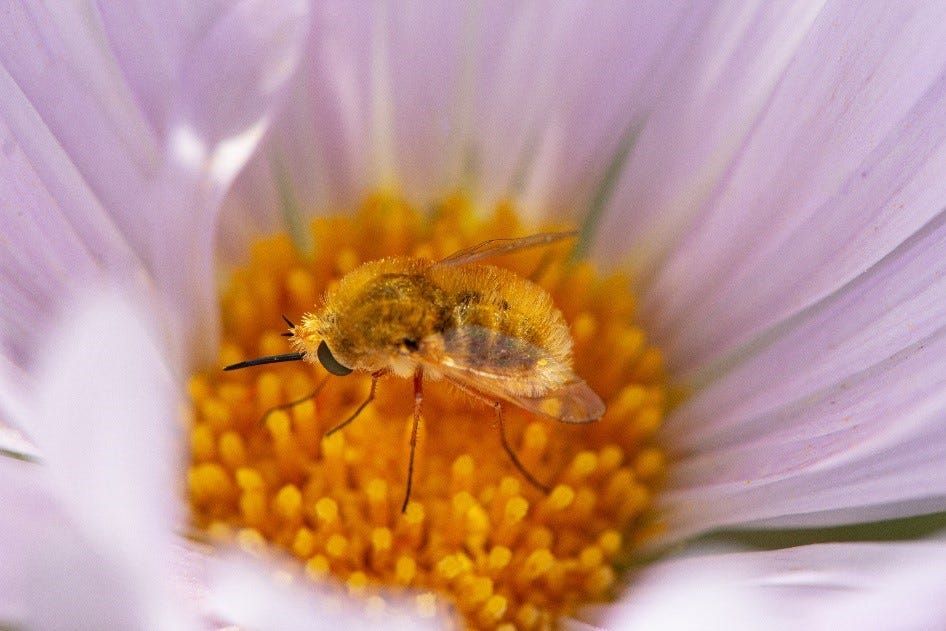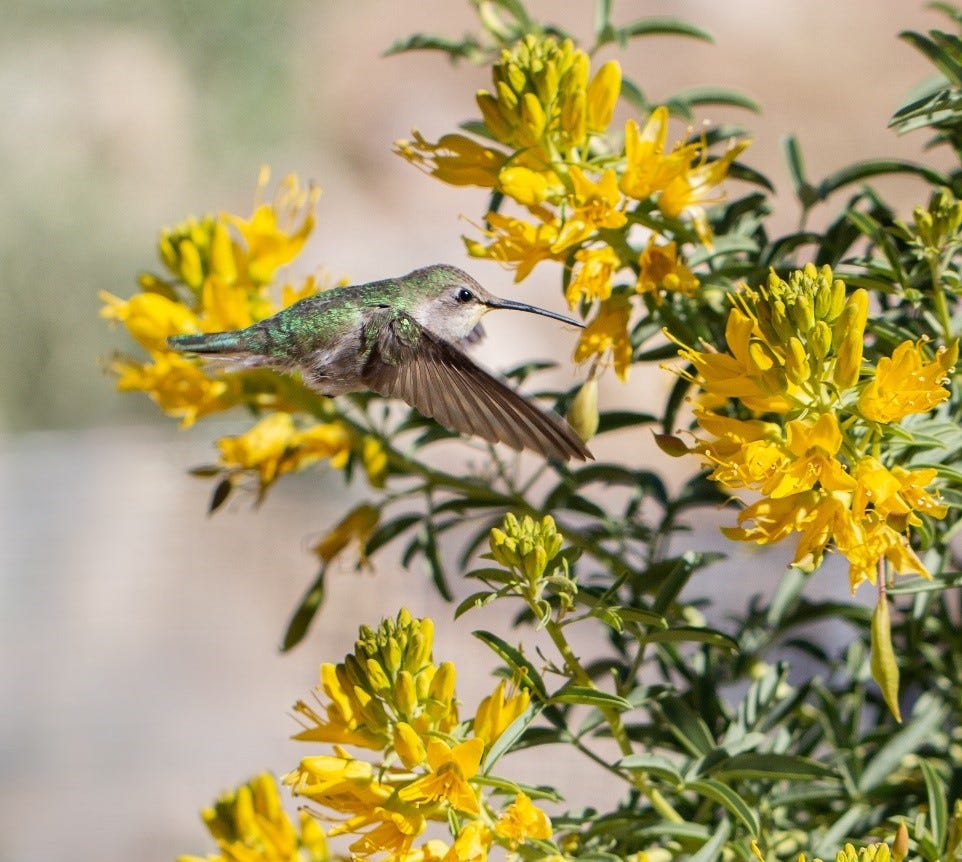How Do Plants In The Desert Behave To Attract Pollinators
This postal service was originally published on this site
Native plants in the Mojave Desert are visited by hummingbirds, bees, and butterflies. These pollinators are vital to our ecosystem. Just they need our aid.

By Madena Asbell, Director of Plant Conservation Programs
Pollinators are among the many animals facing challenges from climate change, invasive species, and other threats. Pollinators are an especially important part of globe's ecosystems considering they are responsible for ensuring the reproduction of most of our planet'southward flowering plants.
According to the Nutrient and Agronomics Organisation of the United Nations, three out of 4 of the world's food crops depend on pollinators — and non just honeybees, only wild pollinators too.
One of the most fascinating things near pollinators is their incredible multifariousness. Plants are pollinated by a host of different animals, including bees, butterflies, moths, flies, beetles, hummingbirds, and bats. MDLT'south new Desert Discovery Garden features planting beds designed specifically for native pollinators. Each of these gardens contains plants that concenter native bees, butterflies and moths, and hummingbirds.
Let me innovate you to some of the Mojave Desert's pollinators and the native plants they depend on.
Native bees
Bees are an incredibly various grouping of insects — the California deserts are home to an estimated 750 native bee species!

Bees come in many shapes, sizes, and colors, from metallic green sweat bees to fuzzy orange carpenter bees to minor striped mining bees.

Dissimilar honeybees, nearly native bees are solitary, building private nests in the ground or in wood cavities. 70% of native bees in Northward America nest in the soil past digging clandestine tubes in which the female lays her eggs. Carpenter bees and mason bees build nests in wood and rock crevices.

Bee flies and mimicry

Some insects take evolved to resemble other species as a strategy to avoid predation. This occurs when an insect with weak defense force mechanisms, such as a fly that is unable to bite or sting, mimics an insect with a strong defense mechanism, like a bee. Bee flies are not bees only flies that imitate bumblebees with their fuzzy bodies. Some bee flies fifty-fifty produce a buzzing audio. They have a long, straw-like mouthpart, called a proboscis, that allows them to drink nectar from flowers much as bees do, and when they visit flowers they collect and distribute pollen that sticks to the hairs on their bodies. 1 reliable manner to distinguish between bees and bee flies is to look at their wings — bees have 2 pairs of wings while flies simply have i pair.
Butterflies and moths
Butterflies are some of our most charismatic pollinators. Accept the monarch, for instance, with its colorful orange and black markings and epic almanac migrations. Most adult collywobbles and moths prefer open flowers with a flat surface on which they can country and feed. This includes the daisy-similar flowers of Acton encelia and brittlebush, clusters of small flowers like those of due east Mojave buckwheat, and many other nectar-rich blossoms. This works out well if you lot take a straw for a mouth (besides known as a proboscis), but what nearly a butterfly's leaf-chewing larvae?

To consummate her lifecycle a butterfly must lay her eggs on an entirely different type of found, one that her caterpillars volition swallow. The plants on which caterpillars feed are chosen "host plants", but unlike humans who can choose what they eat based on personal taste or what happens to be bachelor, caterpillars have evolved to eat very specific plants — if their host plants aren't available, collywobbles and moths cannot reproduce.

Moths are closely related to butterflies and are of import pollinators too. The yucca moth is an example of a pollinator with an uncommonly shut relationship with its host establish. The females of these tiny moths are not just responsible for pollinating our iconic Joshua trees, only they are completely dependent upon this pollination for their ain reproduction.

You see, yucca flowers produce pollen that is too sticky for most insects to collect, but female yucca moths have evolved specialized mouth parts that allow them to gather the pollen and place information technology on the pistil of the flowers.
When she pollinates a flower, the yucca moth also lays her eggs in the ovary of the blossom where the seeds volition develop. The process of pollination leads to fertilization of the ovules which results in the development of seeds on which her caterpillars feed. These two organisms are dependent upon each other for reproduction in a relationship known every bit obligate mutualism.
Hummingbirds

The Mojave and Colorado Deserts are home to four species of hummingbird, although not all are full-time residents. According to Kurt Leuschner, Professor of Natural Resources at College of the Desert, Costa's and Anna'due south hummingbirds can be seen in both deserts year-round, while rufous hummingbirds migrate through during spring and fall, and black-chinned hummingbirds spend only summers in the desert.

Hummingbirds are attracted to colorful nectar-rich flowers that are funnel-shaped or tubular. Some of their favorite native plants are bladderpod, penstemons, and sages. However, nectar isn't the only source of food for these high-free energy birds — they besides need protein, which they go in the course of insects. Protein is an especially important part of their diet during convenance flavour when they feed small-scale insects to their developing chicks. Common insects that hummingbirds consume include aphids, spiders, and gnats.
How can you support pollinators at dwelling?
· Plant a diversity of flowering native plants that attract bees, flies, beetles, butterflies, and hummingbirds.
· Establish both nectar plants for adult collywobbles and moths and the host plants that their caterpillars feed on.
· Maintain patches of open, undisturbed soil where native bees tin nest.
· Construct and install a bee business firm for carpenter and bricklayer bees.
· Avert using insecticides.
· Leave spider webs alone. Hummingbirds feed on spiders and insects trapped in webs, and they use the web textile to construct their nests.
· Participate in an annual butterfly count near y'all.
Source: https://www.mdlt.org/know-your-desert-pollinators-and-the-plants-they-rely-on/

0 Response to "How Do Plants In The Desert Behave To Attract Pollinators"
Post a Comment